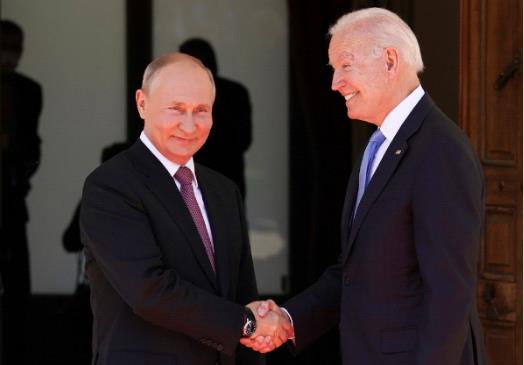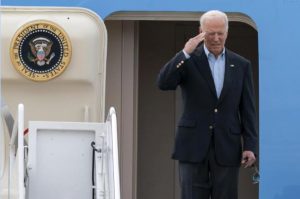Putin-Biden Meeting to Work Towards Nuclear Stability
On June 16, in a highly anticipated meeting, US President Joe Biden and Russian President Vladimir Putin met in Geneva. The Putin-Biden Meeting was being watched and noted with caution by a stream of journalists and an international audience. Russian President Putin said that he and President Biden agreed in the summit to restore the two countries’ ambassadors to their respective positions after they were withdrawn over a recent tiff. Putin described the dialogue with Biden as “constructive” and with “no hostility in a post-meeting media talk.” Describing Biden as the “well-balanced” and “experienced statesman,” Putin acknowledged that “the meeting was actually very efficient. It was substantive and was specific. It was aimed at achieving results, and one of them was pushing back the frontiers of trust.” The talks encompassed the whole range of issues and demonstrated the positions of the two sides.
The first in-person meeting and a high-stakes summit aimed at cooperation but was dominated by deep disagreements were concluded at the Villa La Grange – a lush lakeside Swiss mansion. The main takeaway of the meeting was the agreement of the two sides to enter into a ‘Strategic Stability’ dialogue. Both sides gave their nod to engage in a bilateral dialogue on “strategic stability” to reduce risks of unintentional conflict and restrain the uncontrolled proliferation of nuclear weapons. In addition, the U.S and Russian leaders agreed to begin negotiations to replace the last remaining arms control pact between the two countries. The negotiations would concentrate on potentially replacing the New START treaty that limits nuclear weapons after it expires in 2026.
Signed in 2010, the New START treaty entered into force in 2011. The pact limits the number of strategic nuclear warheads, missiles, and bombers Russia and the U.S can deploy to no more than 1550 strategic nuclear warheads for each side. This is the last arms-control structure left between the two sides after the U.S pulled out from the Intermediate-Range Nuclear Forces (INF) and the Open Skies Arms Control Treaty. The U.S broke off the talks with Russia in 2014 in the aftermath of Russia’s annexation of Ukraine’s Crimea and its military adventurism in the act of endorsement for the separatists in Eastern Ukraine. Talks picked back pace in 2017 but failed to garner support and produce an agreement on extending the New START treaty during the Trump administration.
The two sides released a joint statement on the main area of talks: nuclear proliferation. The statement said: “Nuclear war cannot be won and must never be fought.” However, it said progress on shared goals could be achieved, “even in the periods of tension.” Both countries seek to lay the groundwork for future arms control structure and risk reduction measures. Also, arms control deliberations would be held at the interagency level. Putin pointed out in his Press talks that Russia and the U.S shared the responsibility for nuclear stability. The Biden-Putin summit wrapped at a faster pace than expected, lasting for less than three hours.
It was the first in-person dialogue between two leaders amidst the soaring tensions in the bilateral relationship. The U.S and Russian relations are at historic lows over several points of disagreement. In his post-meeting talks with the media, Biden gave a hint of the summit and the contents of the dialogue. Biden schooled the Russian president for his regime’s abysmal record on human rights issues and over the fate of Russian dissident and opposition leader Alexei Navalny’s detention. He urged Putin to respect the political freedoms in Russia and asked him to re-open the humanitarian corridors in Syria to allow delivery of food and aid and cooperation in preventing Iranian ambition for the acquisition of nuclear weapons.
Another flashpoint of the dialogue was cybersecurity and malicious cyber attacks by Russian hackers on U.S interests. Both sides have traded sharp rhetoric over cyber attacks and security. In line with that, Russian meddling in the U.S elections surfaced in the dialogue where American concerns were explicitly expressed and conveyed. Despite that, Putin, in his post-meeting talks with the Press, defended the detention of Alexei Navalny and evaded responding to the allegations of cyber attacks and threats to the U.S systems. Instead, he deflected attention to the U.S domestic affairs such as Black Lives Matter protests and January 6 Capitol Hill’s riot, implying that the U.S itself is mired in domestic turmoil.
In his media talks, Biden noted that “I told President Putin that we need to have some basic rules of the road that we all abide by.” Areas like Afghanistan, terrorism, the Syrian regime, and the sovereignty of Ukraine all surfaced at the summit, and both sides advanced their stated positions. In March, Biden had called Putin “killer,” downgrading the already sunken relations to further lows. Before the meeting, White House officials had outlined three broad objectives for the summit, stating what they expected the summit to deliver. However, it also noted that major deliverables could not be made from the first meeting.







